| Lot |
Photo |
Description |
Realized |
Lot 195 |
 |
Tail Vertebrae from a T-Rex. All fossils from a T-Rex are in high collector demand being the most famous and popular dinosaur. T-Rex fossils are much scarcer than the plant eating dinosaurs found in the same 66 -68 million year old Hell Creek Formation. This 5 ½ inch X 3 inch light to dark brown tail (caudal) vertebrae is more than three fourths complete. It definitely is from a T-Rex do to the large size of the pores and the large vessel pores prominent on each side of the bone which is found only in the predatory dinosaur T-Rex. This valuable T-Rex bone was found on a private ranch in Wibaux County, Montana. Estimated Value $600 - 1,000
View details and enlarged photo
Unsold |
|
Lot 196 |
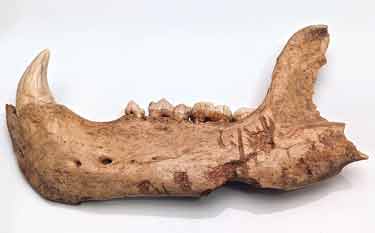 |
Cave Bear Jaw. This complete light brown lower jaw of the huge Ursus spelaeus cave bear is between 20,000-150,000 years old and was found in caves in Romania. The jaw is 9inches long and 5 inches wide complete with all four large molars and a large 2 1/8" canine tooth. Three of the large molars are double molars with two teeth. There is also a bite mark from another predator near the back of the jaw. Estimated Value $400 - 800
View details and enlarged photo
Realized
$300 |
|
Lot 197 |
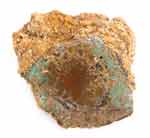 |
Green Chromium Petrified 5X 4 Inch Wood Log. This rare and unusual green color petrified wood log section is from the 200 million year old Woodworthia sp. tree of Goliwe, Zimbabwe. The partial log is 5 inches in diameter and 4 inches thick and has the highly desirable green color on its polished top which occurred when Chromium from the ground water replaced the wood cells of the original tree. This is a good sized specimen as almost all of the petrified wood from Zimbabwe is small in diameter. Estimated Value $400 - 800
View details and enlarged photo
Unsold |
|
Lot 198 |
 |
Primitive Whale Basilosaurus Partial Jaw and Tooth. Whales evolved from a four legged land predator (mesonychids) and the early whales still show characteristics of these bizarre wolf-like animals. Basilosaurus at 60 feet long was the largest predator in the ocean 40 -45 million years ago. Basilosaurus still had vestigial hind limbs and land predator type teeth. The completely natural 4 ½ inch partial jaw contains a large dark brown 2 X 1 ½ inch 6 cusped molar tooth with excellent enamel and one other partial tooth. This odd distinctive molar is double rooted with a high crown that was definitely used to tear flesh apart. This remarkable fossil was found in Wadi El Hitan Egypt which is known as Whale Valley. Basilosaurus is the state vertebrate fossil of Alabama and Mississippi. Estimated Value $300 - 600
View details and enlarged photo
Unsold |
|
Lot 199 |
 |
Large 7 ½ Inch Long Mioplosus Green River Fish. Mioplosus labracoides was an extinct relative of modern day trout. It is over 50 million years old from the famous Green River Formation near Kemmerer, Wyoming. Mioplosus was a predatory fish that had two dorsal fins and a fan-like tail. This large 7 1/2inch long fossil fish is virtually complete with excellent detail in the head, body, fins and even a couple of small teeth. The fish is a light brown color with nearly complete vertebrae and spines and is nicely contrasted on a lighter color limestone matrix. Estimated Value $300 - 600
View details and enlarged photo
Realized
$175 |
|
Lot 200 |
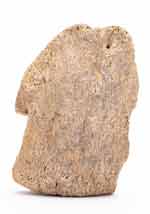 |
Duckbill Dinosaur Toe Bone. Edmontosaurus annectens was a very large herbivore that was a favorite food choice for T-Rex. It is known as a Duckbill dinosaur because of its wide toothless beak. This is a 2 ½ X 1 ½ inch toe bone from one of the front feet. The light brown toe bone is in very good condition displaying fine bone structure. Edmontosaurus had much shorter front legs and could stand upright on its longer and stronger back legs. The claws on the front feet were much smaller than on the back beet. This dinosaur bone is 65-67 million years old and was found on a private ranch in the Lance Creek Formation of Buffalo, South Dakota. Estimated Value $250 - 500
View details and enlarged photo
Unsold |
|
Lot 201 |
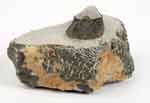 |
Trilobite 2 Inch Harpes Starship Shaped Bug. Harpes is one of the most interesting shaped trilobites that is found in the 385 million year old fossil beds of Erfoud, Morocco. Most trilobites have a very similar shape that takes an expert to tell them apart. Harpes is very distinctive with its wide cephalon along with long spines sweeping back to its tail, this trilobite looks something like a starship. This 2 inch excellent trilobite is complete with even a myriad of small bumps covering all of its surface which are called postules. The black trilobite is nicely centered on a thick 4 1/2 X 2 x 2 inch limestone matrix. Estimated Value $250 - 500
View details and enlarged photo
Unsold |
|
Lot 202 |
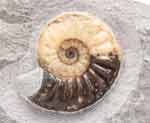 |
Calcified Ammonite from Lyme Regis England. Spiral ammonites are beautiful and widely collected. The lovely ammonites from Lyme Regis, England are particularly attractive especially when part of their shell has been calcified over their 190 million year old age. This 2 inch Promicroceras is large for the species and has half of its shell replaced with yellow calcite crystals and the other half in a dark brown stone. The condition of this complete ammonite is exceptional with its ribs well defined and it sits on its original 8 ½ X2 � inch limestone base. Estimated Value $175 - 400
View details and enlarged photo
Unsold |
|
Lot 203 |
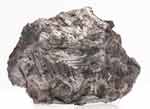 |
Sikhote-Alin 433.2 Gram Shrapnel Type Iron Nickel Meteorite. On February 12, 1947 a series of loud explosions over the Sikhote-Alin mountain range in Siberia announced the arrival of the most recent large Iron-Nickel meteorite to strike the Earth. These meteorites are the best preserved of all the known major falls. There are two different types of meteorites from this fall, meteorites with regmaglypts and shrapnel type meteorites that resulted from a second explosion much closer to the ground. This 3¼ x 2 x 1¼ inch 433.2 gram Sikhote-Alin meteorite is a splendid representative of the shrapnel type with sharp edges, signs of melting around the edges and parallel flow lines in several directions from the melting metal caused by the high temperatures passing through the Earth's atmosphere. Parallel flow lines are seldom found on iron-nickel meteorites that fell hundreds or thousands of years ago due to rusting on the Earth's surface. Estimated Value $900 - 1,500
View details and enlarged photo
Realized
$546 |
|
Lot 204 |
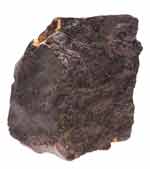 |
NWA869 Stony Meteorite With Fusion Crust. Most stony meteorites are small because the larger stony meteorites either break apart or explode from the extreme pressure of earth's atmosphere. This large 4 ½ x 4 x 2 inch 948 gram (over two pounds) complete stony meteorite is a dark brown color with pristine fusion crust on its top side and two of its sides with the bottom showing typical desert preservation. The pristine side with the fusion crust was buried in the sand and the top side was exposed to harsh desert conditions. It has the official designation NWA 869 meaning that it is the 869th meteorite to be classified from North West Africa and is an ordinary chondrite (L3-L6) stony meteorite that is low in iron. and was found by nomadic Berbers in the sands of the Sahara Desert of Morocco. Estimated Value $400 - 1,000
View details and enlarged photo
Realized
$247 |
|
Lot 205 |
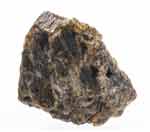 |
Tatahouine Vesta Meteorite. The moon, Mars and Vesta are the only planetary bodies in our solar system where we can positively identify meteorites that originated from their surface. Vesta is a very large asteroid with a diameter of over 326 miles and has a gigantic impact crater at its South Pole that is the source of all of the Vesta meteorites. Tatahouine was named for the city nearest its fall in 1937, Tatahouine, Tunisia. The meteorite Tatahouine is called a Diogenite which comes from very deep inside the huge impact crater. This 5.5 gram complete green meteorite is 17 x 12 x 10 mm. This lovely green meteorite is a good size for a Tatahouine most of which are less than 3 grams. It has a high olivine content and is virtually a virgin rock from Vesta not vaporized and mixed with other rocks like most meteorites. Its green color with black shock lines makes it instantly recognizable as it looks like no other known meteorite. Estimated Value $300 - 900
View details and enlarged photo
Realized
$182 |
|
Lot 206 |
 |
Three Different Types of Vesta Meteorites. The moon, Mars and Vesta are the only planetary bodies in our solar system where we can positively identify meteorites that originated from their surface. NWA 2126 is a polymict Eucrite that formed from the impact of a large asteroid that hit Vesta. This 17 x 10 mm slice weighs 3.8 grams and shows a mixture of the surface rocks from Vesta with white gray light and dark brown inclusions. The second meteorite type is called Howardite and comes from a deeper part of the impact crater. NWA 1281 is a 12 x 10 mm fragment weighing 4.1 grams with a light gray matrix color with some white and dark gray inclusions. The third type of meteorite is called a Diogenite which comes from deeper inside the huge impact crater. This slice of NWA 5480 is 27 x 22 mm weighing 5 grams showing several different colored inclusions in a dark gray matrix. In a 8 x 6 inch Riker mount. Estimated Value $300 - 900
View details and enlarged photo
Unsold |
|
Lot 207 |
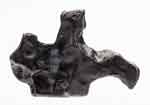 |
Sculpture-like Sikhote-Alin Iron Nickel Meteorite. Sikhote-Aline iron-nickel meteorites are the best preserved of all known iron-nickel meteorites having fallen in Siberia in February, 1947. The best specimens were recovered within a few years and do not show the rust loss that most iron-nickel meteorites show. This sculpture-like 9.8 gram 32 x 22 x 7 mm specimen is a very shape with arm-like extensions with several regmaglypts on its dark gray surface. Comes with a 1¼ inch magnetic stand for display. Estimated Value $200 - 600
View details and enlarged photo
Unsold |
|
Lot 208 |
 |
Four Major Shapes of Indochinite Tektites. When an enormous meteorite impacted the earth 700,000 years ago in Southeast Asia, the vaporized layers of the uppermost layers of rocks solidified in the earth's atmosphere forming the black cratered Tektites know as Indochinites. They are found throughout Southeastern Asia and Southern China. The rate and temperature of solidification as well as the orientation of the rock determined what shapes the glossy black tektites formed. This collection is of the four major shapes. There is a 1½ inch round, a 2¾ inch flattened round disk, a 3¼ inch dumbbell and a 2¾ inch teardrop shape. Estimated Value $200 - 600
View details and enlarged photo
Realized
$124 |
|